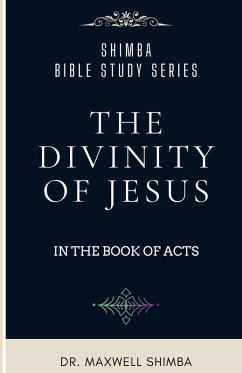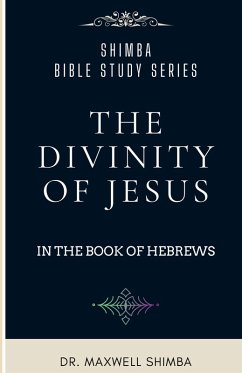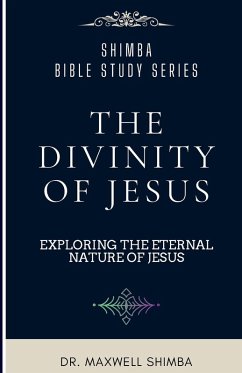
The Divinity of Jesus in the Book of Revelation
Versandkostenfrei!
Versandfertig in 1-2 Wochen
16,99 €
inkl. MwSt.

PAYBACK Punkte
8 °P sammeln!
The Divinity of Jesus in the Book of Revelation The Divinity of Jesus in the Book of Revelation by Dr. Maxwell Shimba offers a profound exploration of how the last book of the Bible reveals the eternal, sovereign, and divine nature of Jesus Christ. Readers should expect a deeply theological study that uncovers the significance of the titles, symbols, and visions that highlight Jesus' supreme authority and majesty throughout the Book of Revelation. From the outset, Dr. Shimba establishes the framework for understanding how Revelation serves as a testament to Christ's exalted role in the cosmic ...
The Divinity of Jesus in the Book of Revelation The Divinity of Jesus in the Book of Revelation by Dr. Maxwell Shimba offers a profound exploration of how the last book of the Bible reveals the eternal, sovereign, and divine nature of Jesus Christ. Readers should expect a deeply theological study that uncovers the significance of the titles, symbols, and visions that highlight Jesus' supreme authority and majesty throughout the Book of Revelation. From the outset, Dr. Shimba establishes the framework for understanding how Revelation serves as a testament to Christ's exalted role in the cosmic order, not just as Savior but as the King of Kings, the righteous Judge, and the Alpha and Omega. In this book, readers are introduced to the many titles that affirm Jesus' divinity, such as the Lamb who was slain, the Root of David, and the Faithful and True Witness. Each of these titles is analyzed in light of their theological significance, offering a deeper understanding of Christ's divine mission. Dr. Shimba dives into how these titles reflect not only Jesus' redemptive role but also His eternal and pre-existent nature, tracing the narrative threads that weave together His identity as both the suffering servant and the victorious King. Readers will find rich insights into the way Revelation glorifies Jesus as the central figure of God's redemptive plan. Dr. Shimba also focuses on the vision of Jesus' enthronement in heaven, as depicted in Revelation chapters 4 and 5. This vision demonstrates the cosmic worship given to Jesus, with the twenty-four elders and the four living creatures bowing before Him. The imagery of Jesus as the Lamb who alone is worthy to open the scroll emphasizes His unique role in executing God's ultimate plan for the world. Readers should expect a detailed analysis of how these heavenly scenes reveal Jesus' sovereignty, linking the Lamb's sacrifice to His authority over the fate of the universe. One of the most crucial aspects that Dr. Shimba highlights is Jesus' role as the righteous judge. In Revelation, Jesus opens the seven seals, unleashes the trumpets, and oversees the bowls of wrath, demonstrating His control over the final judgments of humanity. This portrayal of Jesus as judge underscores the depth of His divine authority, where He is entrusted with the responsibility to bring justice and restore righteousness. Readers will gain insight into the balance of Christ's mercy and justice as they study these powerful apocalyptic images. The book also delves into the eschatological significance of Jesus' return as the triumphant warrior. Dr. Shimba elaborates on the imagery of Jesus riding a white horse in Revelation 19, symbolizing His ultimate victory over evil. This scene illustrates not only the final defeat of Satan, the beast, and the false prophet but also the eternal reign of Christ, who brings peace and justice to the world. Readers should expect a careful exposition of how this vision offers hope to believers, affirming Jesus' divinity and His ultimate triumph over sin and death. Another critical theme that readers will encounter is the creation of the new heaven and new earth in Revelation 21 and 22, where Jesus reigns eternally with His people. Dr. Shimba explains how this vision represents the fulfillment of God's redemptive purposes, with Jesus at the center of the restored creation. The absence of sorrow, pain, and death in this new creation testifies to the completeness of Jesus' work, both as Redeemer and King. Through this, readers are invited to reflect on the significance of Jesus' divinity in shaping the future of humanity and the cosmos.












